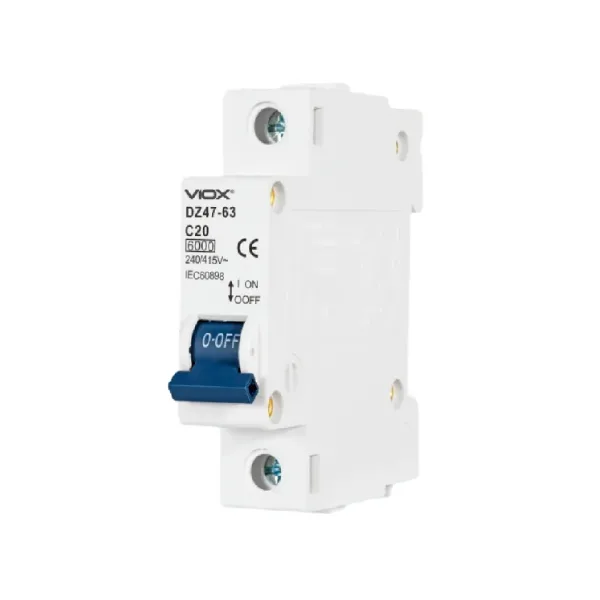သင့်လျော်သော အသေးစား circuit breaker (MCB) ကို ရွေးချယ်ခြင်းသည် လျှပ်စစ်ဘေးကင်းရေး၊ စနစ်ယုံကြည်စိတ်ချရမှုနှင့် ကုဒ်လိုက်နာမှုတို့ကို တိုက်ရိုက်အကျိုးသက်ရောက်စေသည့် အရေးကြီးသော ဆုံးဖြတ်ချက်ဖြစ်သည်။ ဤပြည့်စုံသောလမ်းညွှန်ချက်သည် မည်သည့်အပလီကေးရှင်းအတွက်မဆို MCBs ကိုရွေးချယ်ရာတွင် ထည့်သွင်းစဉ်းစားရမည့် အရေးကြီးသောအချက်များမှတစ်ဆင့် လူနေအိမ်ရာပတ်လမ်းများမှ စက်မှုတပ်ဆင်မှုများအထိဖြစ်သည်။
Miniature Circuit Breakers- ရည်ရွယ်ချက်နှင့် လုပ်ဆောင်ချက်များကို နားလည်ခြင်း။

Miniature circuit breakers များသည် overcurrent ကြောင့်ဖြစ်သော လျှပ်စစ်ဆားကစ်များ ပျက်စီးခြင်းမှ ကာကွယ်ရန် ဒီဇိုင်းထုတ်ထားသော အလိုအလျောက် လျှပ်စစ်ခလုတ်များဖြစ်သည်။ အဆိုပါ overcurrents များသည် အချိန်ကြာလာသည်နှင့်အမျှ ဒီဇိုင်းထွင်ထားသော circuit ထက်ပို၍ လျှပ်စီးကြောင်းကို ဆက်တိုက်ဆွဲယူသွားသည့် သို့မဟုတ် အမှားတစ်ခုကြောင့် ရုတ်တရက် မြင့်မားသော လျှပ်စီးကြောင်းများ ရုတ်တရက် တက်လာသည့် လျှပ်စီးကြောင်းများ ပြတ်တောက်နေသည့် ဤ overcurrent များအဖြစ် ထင်ရှားနိုင်သည်။
လည်ပတ်ပြီးနောက် အစားထိုးရန်လိုအပ်သည့် သမားရိုးကျ fuse များနှင့်မတူဘဲ၊ MCB များသည် အဓိကအားသာချက်များစွာကို ပေးဆောင်သည်-
- စားသုံးနိုင်သော အစိတ်အပိုင်းများ မပါဝင်ဘဲ အလိုအလျောက် လည်ပတ်ခြင်း။
- ပြဿနာဖြေရှင်းရာတွင် ပိုမိုလွယ်ကူစေရန်အတွက် tripped circuit များ၏ အမြင်အာရုံကို ရှင်းလင်းစွာဖော်ပြခြင်း။
- အမှားကင်းရှင်းပြီးနောက် ရိုးရှင်းသော လက်စွဲစာအုပ်ကို ပြန်လည်သတ်မှတ်ပါ။
- အလုံပိတ်ထားသော တိုက်ရိုက်အစိတ်အပိုင်းများဖြင့် လုံခြုံရေးကို မြှင့်တင်ထားသည်။
- ပြန်လည်အသုံးပြုနိုင်ခြင်းဖြင့် ပြုပြင်ထိန်းသိမ်းမှုကုန်ကျစရိတ်ကို လျှော့ချပါ။
MCBs သည် Dual Protection ပေးပုံ
MCB များသည် ပြီးပြည့်စုံသော ဆားကစ်ကို အကာအကွယ်ပေးရန်အတွက် ကွဲပြားသော ယန္တရားနှစ်ခုကို အသုံးပြုသည်-
ဝန်ပိုအခြေအနေများအတွက် အပူဒဏ်ကာကွယ်မှု (bimetallic strip)
- အဆင့်သတ်မှတ်ထားသော တန်ဖိုးများထက် အနည်းငယ် တည်တံ့နေသော ရေစီးကြောင်းများကို တုံ့ပြန်သည်။
- ဝန်ပိုပြင်းအားအတွက် အချိန်နှောင့်နှေးသွားခြင်းကို အချိုးကျ ထောက်ပံ့ပေးသည်။
- ယာယီရေတက်ခြင်းမှ အနှောင့်အယှက်ဖြစ်ခြင်းမှ ကာကွယ်ပေးသည်။
ဝါယာရှော့အခြေအနေများအတွက် သံလိုက်အကာအကွယ် (ဆိုလီနွိုက်နှင့် ပလပ်ဂါ)
- ပြင်းအားမြင့်မားသော ပြတ်ရွေ့ကြောများကို ချက်ချင်းတုံ့ပြန်သည်။
- အန္တရာယ်ရှိသော ဝါယာရှော့များအတွင်း လျင်မြန်သော ဆားကစ်ပြတ်တောက်မှုကို ပံ့ပိုးပေးသည်။
- မြင့်မားသော စွမ်းအင်ချို့ယွင်းမှုများကြောင့် ဖြစ်နိုင်ချေရှိသော ပျက်စီးမှုကို ကန့်သတ်ထားသည်။
ယန္တရားနှစ်ခုလုံး၏ရှိနေခြင်းသည် MCBs များသည် မတူညီသော လျှပ်စစ်ချို့ယွင်းချက်များကို သင့်လျော်စွာ တုံ့ပြန်နိုင်စေပြီး အမျိုးမျိုးသော ဆားကစ်အခြေအနေများနှင့် အံဝင်ခွင်ကျဖြစ်စေသော အလုံးစုံကာကွယ်မှုပေးစွမ်းသည်။
မှန်ကန်သော MCB ကိုရွေးချယ်ခြင်းအတွက် မရှိမဖြစ်အချက်များ
1. မှန်ကန်သော လက်ရှိအဆင့်သတ်မှတ်ခြင်း (In) ကို ဆုံးဖြတ်ခြင်း
In ဟုခေါ်သော လက်ရှိအဆင့်သတ်မှတ်ချက်သည် MCB သည် အကိုးအကားအခြေအနေများအောက်တွင် ခလုတ်မတိုက်ဘဲ အဆက်မပြတ်သယ်ဆောင်နိုင်သော အမြင့်ဆုံးလက်ရှိဖြစ်သည်။ မှန်ကန်သော လက်ရှိအဆင့်သတ်မှတ်ချက်ကို ရွေးချယ်ရာတွင် ထည့်သွင်းစဉ်းစားစရာများစွာ ပါဝင်သည်-
ဒီဇိုင်း Current (IB) ကို တွက်ချက်ပါ- ပထမဦးစွာ သင့်ပတ်လမ်းမှ သယ်ဆောင်မည့် အများဆုံး လျှပ်စီးကြောင်းကို ဆုံးဖြတ်ပါ-
- စက်ပစ္စည်းတစ်ခုတည်းအတွက်- IB = ပါဝါ (ဝပ်) ÷ ဗို့အား
- စက်ပစ္စည်းများစွာအတွက်- တစ်ဦးချင်းစီ လျှပ်စီးကြောင်းများကို ပေါင်းစည်းကာ သင့်လျော်သော ကွဲပြားမှုအချက်များကို အသုံးပြုခြင်း။
အဆက်မပြတ် Loads အတွက် 80%/125% စည်းမျဉ်းကို အသုံးပြုပါ-
3+ နာရီ ဆက်တိုက် လည်ပတ်နေသော ဝန်အားများအတွက်၊ MCB အဆင့်သတ်မှတ်ချက်သည် ဝန်လက်ရှိ၏ အနည်းဆုံး 125% ဖြစ်သင့်သည်-
MCB အဆင့်သတ်မှတ်ချက် (In) ≥ 1.25 × Continuous Load Current (IB)
ဘုံ MCB လက်ရှိ အဆင့်သတ်မှတ်ချက်များ-
- လူနေအလင်းရောင်ဆားကစ်များ- 6A၊ 10A
- အထွေထွေ ပလပ်ပေါက်များ- 16A၊ 20A
- မီးဖိုချောင်သုံးပစ္စည်းများ- 20A၊ 25A၊ 32A
- ရေအပူပေးစက် - 25A မှ 40A
- HVAC စနစ်များ- 32A မှ 63A အထိ
အရေးကြီးသည်- ခလုတ်တိုက်ခြင်းမှ ကာကွယ်ရန် MCB ကို အရွယ်အစားကြီးသည့် အရွယ်အစားကို ဘယ်တော့မှ မကြီးပါ။ ၎င်းသည် ဆားကစ်အကာအကွယ်ကို ထိခိုက်စေပြီး ဖြစ်နိုင်ခြေရှိသော မီးဘေးအန္တရာယ်ကို ဖန်တီးပေးသည်။
2. Voltage Rating ကို System Voltage နှင့် ကိုက်ညီခြင်း။
လုပ်ငန်းလည်ပတ်မှုဗို့အားအဆင့်သတ်မှတ်ချက် (Ue) သည် MCB ကို ဘေးကင်းစွာလည်ပတ်ရန် ဒီဇိုင်းထုတ်ထားသည့် အမြင့်ဆုံးဗို့အားကို သတ်မှတ်ပေးပါသည်။ ဤအဆင့်သတ်မှတ်ချက်သည် သင့်စနစ်၏အမည်ခံဗို့အားထက် ညီမျှသော သို့မဟုတ် ကြီးရမည်ဖြစ်သည်။
ပုံမှန် ဗို့အား အဆင့်သတ်မှတ်ချက်များ
- Single-phase စနစ်များ- 120V (မြောက်အမေရိက), 230V (ဥရောပ)
- အဆင့်သုံးဆင့်စနစ်များ- 400V၊ 415V (လိုင်းမှလိုင်းဗို့အားများ)
DC အက်ပလီကေးရှင်းများအတွက်၊ သဘာဝ လျှပ်စီးကြောင်း သုည-ဖြတ်ကျော်မှုများမရှိခြင်းကြောင့် DC ပြတ်ရွေ့လျှောစီးမှုကို အနှောင့်အယှက်ဖြစ်စေသောကြောင့် အထူးထည့်သွင်းစဉ်းစားရန် လိုအပ်ပါသည်။ လိုအပ်ပါက MCB ကို DC အသုံးပြုရန်အတွက် အထူးတလည် အဆင့်သတ်မှတ်ထားကြောင်း အမြဲစစ်ဆေးပါ။
3. Breaking Capacity- အမြင့်ဆုံးပြတ်ရွေ့လျှပ်စီးကြောင်းအပေါ် ကာကွယ်မှု
Breaking capacity (နှောက်ယှက်နိုင်သောစွမ်းရည်ဟုလည်းခေါ်သည်) သည် MCB မှ ဘေးကင်းစွာ နှောင့်ယှက်နိုင်သော အမြင့်ဆုံးအလားအလာရှိသော short-circuit လက်ရှိကို သတ်မှတ်သည်။ ဤတန်ဖိုးကို ပုံမှန်အားဖြင့် kiloamperes (kA) ဖြင့် ဖော်ပြသည်။
အရေးပါသောဘေးကင်းရေးစည်းမျဉ်း- MCB ၏ ဖောက်ထွင်းနိုင်မှုစွမ်းရည်သည် တပ်ဆင်သည့်အမှတ်တွင် Prospective Short Circuit Current (PSCC) ထက် ကြီးနေရပါမည်။
အဖြစ်များသော Breaking Capacities
- လူနေအိမ်- အနိမ့်ဆုံး 6kA (ထောက်ပံ့ရေးထရန်စဖော်မာနှင့်နီးကပ်ပါက ပိုမြင့်သည်)
- ကုန်သွယ်လုပ်ငန်းခွန်- 10kA နှင့်အထက်
- စက်မှု- 15kA မှ 25kA သို့မဟုတ် ထို့ထက်ပိုသည်။
စွမ်းဆောင်ရည်စံနှုန်းများကို ချိုးဖောက်ခြင်း-
- IEC 60898-1 (လူနေအိမ်)- Icn အဆင့်သတ်မှတ်ချက်ကို အသုံးပြုသည်။
- IEC 60947-2 (စက်မှုလုပ်ငန်း)- Icu (အဆုံးစွန်) နှင့် Ics (ဝန်ဆောင်မှု) အဆင့်သတ်မှတ်ချက်များကို အသုံးပြုသည်
- UL 489 (မြောက်အမေရိက) : ပုံမှန်အားဖြင့် 10kA သည် စံသတ်မှတ်ချက်များဖြစ်သည်။
ဖောက်ထွင်းမှုစွမ်းရည် မလုံလောက်ပါက ချို့ယွင်းချက်တစ်ခုအတွင်း ဆိုးရွားသော MCB ချို့ယွင်းမှုကို ဖြစ်ပေါ်စေနိုင်ပြီး မီး သို့မဟုတ် စက်ပစ္စည်းများ ပျက်စီးမှုအထိ ဖြစ်စေနိုင်သည်။
4. သင့်လျော်သော Tripping Curve ကို ရွေးချယ်ခြင်း။

tripping curve သည် MCB သည် overcurrents များကို မည်မျှလျင်မြန်စွာ တုံ့ပြန်သည်၊ အထူးသဖြင့် ၎င်း၏ instantaneous (magnetic) tripping threshold ကို သတ်မှတ်သည်။ ဤအင်္ဂါရပ်ကို သင်၏ ဝန်ပရိုဖိုင်နှင့် ကိုက်ညီစေခြင်းသည် အနှောက်အယှက်မဖြစ်စေဘဲ ကာကွယ်မှုသေချာစေရန်အတွက် အရေးကြီးပါသည်။
အမျိုးအစား B (3-5 × In):
- အတွက် အကောင်းဆုံး- အနိမ့်ဆုံး inrush current ဖြင့် ခံနိုင်ရည်ရှိသော ဝန်များ
- အသုံးချမှုများ- အထွေထွေအလင်းရောင်၊ အပူဒြပ်စင်များ၊ လူနေအိမ်ဆားကစ်များ
- ဥပမာများ- မီးခိုးအလင်းရောင်၊ ခံနိုင်ရည်ရှိ အပူပေးစက်များ၊ အထွေထွေ အိမ်တွင်းအသုံးပြုမှု
အမျိုးအစား C (5-10 × In):
- အတွက် အကောင်းဆုံး- အချို့သော inrush current ဖြင့် အလယ်အလတ် လျှပ်ကူးပစ္စည်း ဝန်များ
- အသုံးချမှုများ- အသေးစားမော်တာများ၊ လုပ်ငန်းသုံးပစ္စည်းများ၊ ချောင်းအလင်းရောင်
- ဥပမာ- ပန်ကာများ၊ ပန့်များ၊ လုပ်ငန်းသုံး ပလပ်ပေါက်များ၊ အိုင်တီပစ္စည်းများ
D (10-20 × In) အမျိုးအစား-
- အတွက် အကောင်းဆုံး- သိသာထင်ရှားသော inrush current ပါသော လျှပ်ကူးပစ္စည်း မြင့်မားသော ဝန်များ
- အသုံးချမှုများ- မော်တာကြီးများ၊ ထရန်စဖော်မာများ၊ စက်မှုပစ္စည်းများ
- ဥပမာ- ကွန်ပရက်ဆာများ၊ ဂဟေဆက်ကိရိယာများ၊ စက်မှုစက်ပစ္စည်းများ
အမျိုးအစား K (8-12 × In):
- အကောင်းဆုံး- ဟန်ချက်ညီသောကာကွယ်မှုလိုအပ်သော Inductive loads
- အပလီကေးရှင်းများ- overload sensitivity ဖြင့် inrush tolerance လိုအပ်သော မော်တာများ၊ ထရန်စဖော်မာများ
- ဥပမာ- ကွန်ပရက်ဆာများ၊ ဓာတ်မှန်စက်များ၊ အကွေ့အကောက်များသော မော်တာများ
Z အမျိုးအစား (2-3 × In):
- အကောင်းဆုံး- အမြန်ကာကွယ်မှုလိုအပ်သော အာရုံခံအီလက်ထရွန်နစ်ပစ္စည်းများ
- အသုံးချပရိုဂရမ်များ- တစ်ပိုင်းလျှပ်ကူးကိရိယာများ၊ ထိန်းချုပ်ပတ်လမ်းများ
- ဥပမာ- PLC များ၊ ဆေးဘက်ဆိုင်ရာပစ္စည်းများ၊ တိုင်းတာမှုစနစ်များ
မှားယွင်းသောမျဉ်းကွေးကို ရွေးချယ်ခြင်းသည် အနှောင့်အယှက်ဖြစ်စေသည် (အထိခိုက်မခံလွန်းလျှင်) သို့မဟုတ် အကာအကွယ်မလုံလောက်မှု (အလုံအလောက်မထိခိုက်နိုင်လျှင်) ဖြစ်ပေါ်စေသည်။
5. ဝင်ရိုးစွန်းအရေအတွက်- Single-Phase နှင့် Three-Phase Applications
အမျိုးမျိုးသော circuit configuration များနှင့်ကိုက်ညီရန် MCB များကို မတူညီသော နံပါတ်များဖြင့် ရရှိနိုင်ပါသည်။
ဝင်ရိုးစွန်းတစ်ခု (SP)-
- အဆင့်စပယ်ယာကို ကာကွယ်ပေးသည်။
- မြောက်အမေရိက လူနေစနစ်များတွင် အဖြစ်များသည်။
နှစ်ထပ်ဝင်ရိုး (DP)-
- conductor နှစ်ခုကို တစ်ပြိုင်နက် ကာကွယ်ပေးသည်။
- single-phase circuits (phase နှင့် neutral) သို့မဟုတ် two-phase conductors များအတွက် အသုံးပြုသည်။
- ပတ်လမ်းကို အပြည့်အဝ သီးခြားခွဲထားရန် သေချာစေပါသည်။
Triple-Pole (TP)-
- အဆင့်သုံးဆင့်အားလုံးကို ကာကွယ်ပေးပါသည်။
- single-phasing ပျက်စီးမှုကိုကာကွယ်ရန် three-phase motors များအတွက် မရှိမဖြစ်လိုအပ်ပါသည်။
လေးတိုင် (4P/TPN)-
- အဆင့်သုံးဆင့်စလုံးနှင့် ကြားနေကို ကာကွယ်ပေးသည်။
- ကြားနေ ကူးပြောင်းခြင်း/ကာကွယ်မှု လိုအပ်သည့် သုံးဆင့်၊ လေးကြိုးစနစ်များတွင် အသုံးပြုသည်။
Multi-pole MCBs များတွင် တူညီသော ခရီးယန္တရားများ ပါ၀င်သည် ၊ တိုင်တစ်ခုမှ တစ်ခုခု တွင် ချို့ယွင်းချက် ဖြစ်ပေါ်ပါက တိုင်များအားလုံး တစ်ပြိုင်နက် ချိတ်ဆက်မှု ပြတ်တောက်ကြောင်း သေချာစေသည်— အဆင့်သုံးဆင့် စနစ်များအတွက် အရေးကြီးသော ဘေးကင်းရေး အင်္ဂါရပ် ဖြစ်သည်။

6. စပယ်ယာအရွယ်အစားနှင့် ညှိနှိုင်းဆောင်ရွက်ခြင်း
အခြေခံ MCB လုပ်ဆောင်ချက်သည် circuit conductors များကို ကာကွယ်ပေးသည်။ ၎င်းသည် MCB အဆင့်သတ်မှတ်ချက်နှင့် ဝါယာကြိုး၏ လက်ရှိသယ်ဆောင်နိုင်သော စွမ်းရည် (ampacity) အကြား သင့်လျော်သော ညှိနှိုင်းမှု လိုအပ်သည်။
မရှိမဖြစ် ပူးပေါင်းဆောင်ရွက်ရေး စည်းမျဉ်းများ-
- MCB ၏ အဆင့်သတ်မှတ်ထားသော လက်ရှိ (In) သည် conductor ၏ ampacity (IZ) ထက် မကျော်လွန်ရပါ။- ≤ IZ တွင်၊
- ဒီဇိုင်းလက်ရှိ (IB) သည် MCB ၏ အဆင့်သတ်မှတ်ထားသော လက်ရှိနှင့် လျော့နည်းရမည်- IB ≤ ≤ IZ တွင်၊
- IEC စံနှုန်းများအရ၊ သမားရိုးကျ tripping current (I2) သည် conductor ၏ ampacity 1.45 ဆထက် နည်းရမည်- I2 ≤ 1.45 × IZ
စပယ်ယာအရွယ်အစား မမှန်ကန်ခြင်းသည် သာမန်နှင့် အန္တရာယ်ရှိသော အမှားတစ်ခုဖြစ်သည်။ MCB အဆင့်သတ်မှတ်ချက်အတွက် သေးငယ်လွန်းသော စပယ်ယာများကို အသုံးပြုခြင်းသည် အပူလွန်ကဲခြင်းနှင့် မီးလောင်ကျွမ်းခြင်းတို့ကို ဖြစ်စေနိုင်သော်လည်း အရွယ်အစားကြီးမားသော MCB များသည် conductors များကို လုံလောက်စွာ မကာကွယ်နိုင်ပါ။
7. စံချိန်စံညွှန်းများနှင့် အသိအမှတ်ပြုလက်မှတ် လိုအပ်ချက်များ
MCB များသည် ၎င်းတို့၏ ဘေးကင်းရေးနှင့် စွမ်းဆောင်ရည်လိုအပ်ချက်များကို သတ်မှတ်ပေးသည့် သက်ဆိုင်ရာ နိုင်ငံတကာ သို့မဟုတ် ဒေသဆိုင်ရာ စံနှုန်းများကို လိုက်နာရမည်-
အဓိက နိုင်ငံတကာစံနှုန်းများ-
- IEC 60898-1- အိမ်သုံးနှင့် အလားတူ တပ်ဆင်မှုများ (လူနေအိမ်များအတွက်)
- IEC 60947-2- စက်မှုအသုံးချမှုများအတွက်
- UL 489- မြောက်အမေရိကရှိ ဌာနခွဲပတ်လမ်းကာကွယ်ရေးအတွက်
- UL 1077- စက်ပစ္စည်းများအတွင်း ဖြည့်စွက်အကာအကွယ်အတွက် (ဌာနခွဲဆားကစ်များအတွက်မဟုတ်)
အရေးကြီးသော လက်မှတ်များ-
- CE အမှတ်အသား (ဥရောပလိုက်နာမှု)
- UL စာရင်း (မြောက်အမေရိက)
- VDE၊ KEMA၊ TÜV (ဥရောပစမ်းသပ်မှုအဖွဲ့များ)
လုံခြုံစိတ်ချရမှုစံနှုန်းများနှင့် မကိုက်ညီသောကြောင့် အာမခံမထားသော သို့မဟုတ် အတုအပ MCB များကို ဘယ်တော့မှ မသုံးပါနှင့်၊ လိုအပ်သည့်အခါတွင် ဘေးဥပဒ်ဖြစ်စေနိုင်သည်။
လက်တွေ့ကျ MCB ရွေးချယ်မှုလုပ်ငန်းစဉ်- အဆင့်ဆင့်လမ်းညွှန်

အဆင့် 1- လျှပ်စစ်စနစ်နှင့် ဝန်ကို အကဲဖြတ်ပါ။
သင့်လျှပ်စစ်စနစ်နှင့်ပတ်သက်သော မရှိမဖြစ်လိုအပ်သော အချက်အလက်များကို စုဆောင်းခြင်းဖြင့် စတင်ပါ။
- စနစ်ဗို့အားနှင့်ကြိမ်နှုန်း
- AC သို့မဟုတ် DC ပါဝါ
- Single-phase သို့မဟုတ် သုံးဆင့် ဖွဲ့စည်းမှု
- အသေးစိတ်ဝန်အချက်အလက် (ပါဝါအဆင့်သတ်မှတ်ချက်များ၊ နှိုက်နှိုက်ချွတ်ချွတ်လက္ခဏာများ)
အဆင့် 2- ဒီဇိုင်း Current ကို တွက်ချက်ပါ။
သင့်ပတ်လမ်းတွင် သယ်ဆောင်မည့် အများဆုံး လျှပ်စီးကြောင်းကို ဆုံးဖြတ်ပါ-
- စက်ပစ္စည်းတစ်ခုတည်းအတွက်- ပါဝါ ÷ ဗို့အား = လက်ရှိ
- စက်ပစ္စည်းများစွာအတွက်- သင့်လျော်သောကွဲပြားမှုအချက်များဖြင့် တစ်ဦးချင်းစီလျှပ်စီးကြောင်းများကို ပေါင်းစည်းပါ။
- စဉ်ဆက်မပြတ် loads အတွက် 125% အချက်ကို အသုံးပြုပါ။
အဆင့် 3- conductor အရွယ်အစားနှင့် စွမ်းဆောင်ရည်ကို သတ်မှတ်ပါ။
သင့်လျော်သော ဝါယာကြိုးအရွယ်အစားကို ရွေးချယ်ပါ-
- ဒီဇိုင်းလက်ရှိတွက်ချက်
- တပ်ဆင်ခြင်းနည်းလမ်း (ပြွန်၊ ကေဘယ်ဗန်း စသည်ဖြင့်)
- ပတ်ဝန်းကျင်အပူချိန်
- ကေဘယ်များစွာ အတူတူလည်ပတ်ပါက အချက်များကို အုပ်စုဖွဲ့ပါ။
အဆင့် 4- Prospective Short Circuit Current (PSCC) ကို တွက်ချက်ပါ။
တပ်ဆင်သည့်နေရာရှိ PSCC ကို အောက်ပါတို့မှတဆင့် ဆုံးဖြတ်နိုင်သည်။
- Transformer parameters များနှင့် cable impedances များအပေါ် အခြေခံ၍ တွက်ချက်ခြင်း။
- utility provider မှအချက်အလက်များ
- အထူးပြု စက်ကိရိယာများကို အသုံးပြု၍ တိုင်းတာခြင်း။
- တပ်ဆင်မှုလက္ခဏာများပေါ်အခြေခံ၍ ရှေးရိုးဆန်သော ခန့်မှန်းချက်
အဆင့် 5- MCB Breaking Capacity ကို ရွေးပါ။
တွက်ချက်ထားသော PSCC ထက် ပိုကြီးသော MCB ကို ရွေးပါ-
- လူနေထိုင်ခြင်းဆိုင်ရာ လျှောက်လွှာများ- အနည်းဆုံး 6kA (လုံခြုံရေးအတွက် မကြာခဏ 10kA)
- ကုန်သွယ်လုပ်ငန်းခွန်- 10kA နှင့်အထက်
- စက်မှု- ထောက်ပံ့ရန်နီးစပ်မှုပေါ် မူတည်၍ 15-25kA သို့မဟုတ် ထို့ထက် ပိုသည်။
အဆင့် 6- သင့်လျော်သော Tripping Curve ကို ရွေးပါ။
ဝန်လက္ခဏာများပေါ်အခြေခံ၍
- ခုခံအားများ- အမျိုးအစား B
- အသေးစားမော်တာများ၊ လုပ်ငန်းသုံးပစ္စည်းများ- Type C
- ကြီးမားသော မော်တာများ၊ ထရန်စဖော်မာများ- Type D
- ထိလွယ်ရှလွယ် အီလက်ထရွန်နစ်ပစ္စည်းများ- Type Z
အဆင့် 7- လိုအပ်သော ဝင်ရိုးစွန်းအရေအတွက်ကို သတ်မှတ်ပါ။
စနစ်ဖွဲ့စည်းပုံအပေါ် အခြေခံ၍-
- Single-phase (အဆင့်သာ): Single-pole
- အဆင့်တစ်ခုတည်း (အဆင့်နှင့် ကြားနေ): နှစ်ထပ်ဝင်ရိုးစွန်း
- အဆင့်သုံးဆင့် (ဘက်မလိုက်ဘဲ)- သုံးတိုင်
- အဆင့်သုံးဆင့် (ကြားနေဖြင့်): လေးတိုင်
အဆင့် 8- လျှပ်စစ်ကုဒ်များနှင့် ကိုက်ညီမှုရှိမရှိ စစ်ဆေးပါ။
ရွေးချယ်မှုသည် ဒေသန္တရလျှပ်စစ်ကုဒ်သတ်မှတ်ချက်များနှင့် ကိုက်ညီကြောင်း သေချာစေသည်-
- Overcurrent ကာကွယ်မှု
- အဆက်ဖြတ်ခြင်းကို ဆိုလိုသည်။
- သုံးစွဲနိုင်မှု
- တပ်ဆင်မှုလိုအပ်ချက်များ
အသုံးများသော အပလီကေးရှင်းများအတွက် MCB ရွေးချယ်မှု နမူနာများ
ဥပမာ 1- လူနေအိမ် မီးချောင်းပတ်လမ်း
ဇာတ်လမ်း-
- LED မီးချောင်း ၁၀ လုံး၊ တစ်ခုစီသည် 15W (စုစုပေါင်း 150W) ဖြင့် အဆင့်သတ်မှတ်သည်
- Single-phase, 230V AC စနစ်
ရွေးချယ်ရေး လုပ်ငန်းစဉ်-
- ဒီဇိုင်းလက်ရှိတွက်ချက်ရန်- 150W ÷ 230V = 0.65A
- စဉ်ဆက်မပြတ်ဝန်အတွက် 125% စည်းမျဉ်းကို အသုံးပြုပါ- 0.65A × 1.25 = 0.81A
- MCB အဆင့်သတ်မှတ်ချက်ကို ရွေးပါ- 6A (အသေးဆုံးစံနှုန်းသတ်မှတ်မှု)
- စပယ်ယာအရွယ်အစား- 1.5 မီလီမီတာ စတုရန်းကြေးနီ (6A ထက် စွမ်းဆောင်ရည်ကောင်းမွန်သည်)
- ဖောက်ထွင်းနိုင်စွမ်းအား- 6kA (စံလူနေအိမ်)
- Tripping curve- Type B (LED အလင်းရောင်တွင် အနည်းငယ်သာ ပါဝင်သည်)
- တိုင်အရေအတွက်- နှစ်ထပ်တိုင် (အဆင့်နှင့် ကြားနေ)
ရလဒ်- 6A၊ Type B၊ Double-pole၊ 6kA MCB
ဥပမာ 2- မီးဖိုချောင်သုံး စက်ပတ်လမ်း
ဇာတ်လမ်း-
- 2kW မီးဖို + 1kW မိုက်ခရိုဝေ့
- Single-phase, 230V AC စနစ်
ရွေးချယ်ရေး လုပ်ငန်းစဉ်-
- ဒီဇိုင်းလက်ရှိတွက်ချက်ရန်-
- မီးဖို: 2000W ÷ 230V = 8.7A
- မိုက်ခရိုဝေ့: 1000W ÷ 230V = 4.35A
- ပေါင်းစပ်အထွတ်အထိပ်- 13.05A
- 125% စည်းမျဉ်းကို အသုံးပြုပါ- 8.7A × 1.25 = 10.9A (စဉ်ဆက်မပြတ် မီးဖိုအသုံးပြုမှုအတွက်)
- MCB အဆင့်သတ်မှတ်ချက်- 16A ကို ရွေးပါ။
- စပယ်ယာအရွယ်အစား- 2.5mm² ကြေးနီ (16A အတွက် သင့်လျော်သည်)
- ဖောက်ထွင်းနိုင်စွမ်း: 6kA
- Tripping curve- Type C (မိုက်ခရိုဝေ့ဖ်မှ အလယ်အလတ် နှိုက်နှိုက်မှုကို ဖြည့်ဆည်းပေးသည်)
- တိုင်အရေအတွက်- နှစ်ထပ်တိုင်
ရလဒ်- 16A၊ Type C၊ Double-pole၊ 6kA MCB
ဥပမာ 3- အလုပ်ရုံ အသေးစား မော်တော်
ဇာတ်လမ်း-
- 0.75kW (1HP) single-phase မော်တာ
- ပါဝါအချက် = 0.8၊ စွမ်းဆောင်ရည် = 80%
- 230V AC စနစ်
ရွေးချယ်ရေး လုပ်ငန်းစဉ်-
- ထည့်သွင်းပါဝါကို တွက်ချက်ပါ- 0.75kW ÷ 0.8 = 0.938kW
- ဒီဇိုင်းလက်ရှိတွက်ချက်ရန်- 938W ÷ (230V × 0.8) = 5.1A
- 125% စည်းမျဉ်းကို အသုံးပြုပါ- 5.1A × 1.25 = 6.4A
- မော်တာ inrush- 5.1A × 8 = 40.8A (8 × FLC inrush ဟု ယူဆသည်)
- MCB အဆင့်သတ်မှတ်ချက်- 10A ကို ရွေးပါ။
- ဖောက်ထွင်းနိုင်စွမ်း: 6kA
- Tripping curve- Type C သို့မဟုတ် D ( motor inrush ကြာချိန်ပေါ်မူတည်၍ )
- တိုင်အရေအတွက်- နှစ်ထပ်တိုင်
ရလဒ်- 10A၊ Type C၊ Double-pole၊ 6kA MCB (သို့မဟုတ် Inrush အထူးမြင့်မားပါက Type D)
MCBs ကိုရွေးချယ်ရာတွင် ရှောင်ရှားရန် ဘုံအမှားများ
- MCB လက်ရှိအဆင့်သတ်မှတ်ချက်ကို အကဲဖြတ်ခြင်း- အဆင့်သတ်မှတ်ထားသော လက်ရှိထက် သိသိသာသာမြင့်မားသော MCB တစ်ခုကို ရွေးချယ်ခြင်းသည် စပယ်ယာအကာအကွယ်ကို ထိခိုက်စေပြီး မီးဘေးအန္တရာယ်ကို ဖန်တီးပေးသည်။
- ဖောက်ထွင်းနိုင်မှု မလုံလောက်ခြင်း- PSCC အောက်တွင် ဖောက်ထွင်းနိုင်စွမ်းရှိသော MCB ကို အသုံးပြုခြင်းသည် အမှားတစ်ခုအတွင်း ကပ်ဆိုးတစ်ခု ပျက်ကွက်ခြင်းသို့ ဦးတည်သွားစေနိုင်သည်။
- အပလီကေးရှင်းအတွက် tripping curve မှားယွင်းနေသည်- အနှောင့်အယှက်ဖြစ်စေသည် (အလွန်အမင်းထိခိုက်ပါက) သို့မဟုတ် အကာအကွယ်မလုံလောက်ခြင်း (အလုံအလောက်မထိခိုက်နိုင်လျှင်) ဖြစ်စေသည်။
- စပယ်ယာညှိနှိုင်းမှုကို လျစ်လျူရှုခြင်း- conductor ampacity ဖြင့် MCB အဆင့်သတ်မှတ်ချက်ကို ကောင်းစွာညှိနှိုင်းရန်ပျက်ကွက်ခြင်းသည် ဆားကစ်လုံခြုံရေးကို ထိခိုက်စေပါသည်။
- အသိအမှတ်ပြုမထားသော ထုတ်ကုန်များကို အသုံးပြုခြင်း- လက်မှတ်မထိုးထားသော သို့မဟုတ် အတုအပ MCB များကို တပ်ဆင်ခြင်းသည် လေးနက်သော ဘေးကင်းမှုနှင့် ယုံကြည်စိတ်ချရမှု အန္တရာယ်များကို ပြသသည်။
- မှားယွင်းစွာတပ်ဆင်ခြင်း- ညံ့ဖျင်းသော terminal ချိတ်ဆက်မှုများ၊ မမှန်သောဝိုင်ယာကြိုးများနှင့် ပြည့်ကျပ်နေသော အကာအရံများသည် MCB စွမ်းဆောင်ရည်ကို အလျှော့အတင်းလုပ်နိုင်သည်။
- ပတ်ဝန်းကျင်ဆိုင်ရာအချက်များအား လျစ်လျူရှုခြင်း- ပတ်ဝန်းကျင်အပူချိန်၊ အမြင့်ပေ သို့မဟုတ် စိုထိုင်းဆကို ထည့်သွင်းစဉ်းစားရန် ပျက်ကွက်ခြင်းသည် MCB စွမ်းဆောင်ရည်ကို ထိခိုက်စေနိုင်သည်။
- မလုံလောက်သော အနာဂတ်အစီအစဉ်- ဖြစ်နိုင်ချေရှိသော ဝန်တိုးနှုန်းအတွက် စာရင်းမပြုစုပါက အချိန်မတန်မီ စနစ်ပိုလျှံမှုများ ဖြစ်စေနိုင်သည်။
ပရော်ဖက်ရှင်နယ် လျှပ်စစ်ပညာရှင်ကို ဘယ်အချိန်မှာ တိုင်ပင်ရမလဲ
ဤလမ်းညွှန်ချက်သည် ပြည့်စုံသောအချက်အလက်များကို ပေးစွမ်းသော်လည်း၊ ပရော်ဖက်ရှင်နယ် ကျွမ်းကျင်မှု မရှိမဖြစ် လိုအပ်သည့် အခြေအနေများ ရှိပါသည်။
- ပါဝါရင်းမြစ်များစွာဖြင့် ရှုပ်ထွေးသော လျှပ်စစ်စနစ်များ
- သုံးဆင့်ပါဝါတပ်ဆင်ခြင်း။
- PSCC က ဘယ်အချိန်မှာ စိတ်ချယုံကြည်စွာ တွက်ချက်လို့မရပါဘူး။
- အကာအကွယ်ကိရိယာများအကြား ရွေးချယ်ညှိနှိုင်းမှု လိုအပ်သော တပ်ဆင်မှုများ
- ဆက်တိုက်လျှပ်စစ်ပြဿနာများကြုံတွေ့ရသောအခါ
- သင့်လျော်သောရွေးချယ်မှု သို့မဟုတ် တပ်ဆင်ခြင်းနှင့်ပတ်သက်၍ သင်မသေချာသည့်အခြေအနေတိုင်း
နိဂုံး- မှန်ကန်သော MCB ရွေးချယ်မှုဖြင့် လျှပ်စစ်အန္တရာယ်ကို အာမခံပါသည်။
မှန်ကန်သော အသေးစား circuit breaker ကိုရွေးချယ်ခြင်းသည် လျှပ်စစ်စနစ်ဘေးကင်းမှု၊ ယုံကြည်စိတ်ချရမှုနှင့် လိုက်နာမှုတို့ကို တိုက်ရိုက်အကျိုးသက်ရောက်စေသည့် အရေးကြီးသောအလုပ်ဖြစ်သည်။ လက်ရှိအဆင့်သတ်မှတ်ချက်များ၊ ကွဲထွက်နိုင်စွမ်း၊ ခလုတ်တိုက်သည့်လက္ခဏာများနှင့် စပယ်ယာညှိနှိုင်းခြင်းကို ဂရုတစိုက်ထည့်သွင်းစဉ်းစားခြင်းဖြင့်၊ သင်၏လျှပ်စစ်ဆားကစ်များကို overloads နှင့် short circuit နှစ်ခုလုံးမှ ကာကွယ်ထားကြောင်း သေချာစေနိုင်ပါသည်။
MCB ၏ အဓိကရည်ရွယ်ချက်မှာ ဘေးကင်းရေးဖြစ်သည်- ငွေချွေတာရန် သို့မဟုတ် အနှောင့်အယှက်ဖြစ်ခြင်းမှ ရှောင်ရှားရန် သတ်မှတ်ချက်များအပေါ် ဘယ်သောအခါမှ အလျှော့မပေးကြောင်း သတိရပါ။ မှန်ကန်စွာရွေးချယ်ပြီး တပ်ဆင်ထားသည့် MCB သည် သင့်လျှပ်စစ်စနစ်အတွက် မရှိမဖြစ်လိုအပ်သော အကာအကွယ်ကိုပေးသည်၊ ပစ္စည်းဥစ္စာများနှင့် လူများကို လျှပ်စစ်အန္တရာယ်မှ ကာကွယ်ပေးပါသည်။
မကြာခဏမေးမေးခွန်းများ
မေး- 15A ဘရိတ်ကာကို 20A ဘရိတ်ကာနဲ့ အစားထိုးလို့ရပါသလား။
A- မဟုတ်ပါ၊ ၎င်းသည် အန္တရာယ်ရှိပြီး လျှပ်စစ်ကုဒ်များကို ချိုးဖောက်နိုင်ချေရှိသည်။ သင်၏ ဘရိတ်ကာသည် မကြာခဏ လည်ပတ်နေပါက၊ ပုံမှန်အားဖြင့် circuit overload သို့မဟုတ် ချို့ယွင်းမှု၏ မူလအကြောင်းရင်းကို စစ်ဆေးပါ။ ဖြေရှင်းချက်တွင် အများအားဖြင့် ဝန်များကို ပြန်လည်ဖြန့်ဝေခြင်း သို့မဟုတ် ဆားကစ်များ ပေါင်းထည့်ခြင်း ၊ breaker အရွယ်အစားကို မတိုးစေဘဲ ပါဝင်သည်။
မေး- MCB တွေကို ဘယ်နှစ်ကြိမ် အစားထိုးရမလဲ။
A- MCB များတွင် သတ်မှတ်ထားသော သက်တမ်းကုန်ဆုံးရက်မရှိသော်လည်း စမ်းသပ်နေစဉ်အတွင်း ပျက်စီးခြင်း၊ ဝတ်ဆင်ခြင်း သို့မဟုတ် ပျက်ကွက်ခြင်း လက္ခဏာများပြသပါက အစားထိုးသင့်ပါသည်။ အရည်အသွေးမီ MCB အများစုသည် ပုံမှန်အခြေအနေအောက်တွင် 10-20 နှစ်ကြာသည်။
မေး- MCBs နှင့် RCDs/GFCIs အကြားကွာခြားချက်ကဘာလဲ
A- MCBs များသည် overcurrent (overloads နှင့် short circuits) ကို ကာကွယ်ပေးပြီး RCDs (Residual Current Devices) သို့မဟုတ် GFCIs (Ground Fault Circuit Interrupters) သည် လက်ရှိ မြေပြင်သို့ ယိုစိမ့်မှုမှ ကာကွယ်ပေးပါသည်။ ခေတ်မီတပ်ဆင်မှုများစွာသည် လုပ်ဆောင်ချက်နှစ်ခုလုံးကိုပေါင်းစပ်ထားသည့် RCBOs ကိုအသုံးပြုသည်။
မေး- ကျွန်ုပ်၏ panel ထက် အခြားထုတ်လုပ်သူထံမှ MCB ကို သုံးနိုင်ပါသလား။
A- တစ်ခါတစ်ရံ ဖြစ်နိုင်သော်လည်း၊ သင့်အကန့်နှင့် သင့်လျော်သော စွမ်းဆောင်ရည်၊ စွမ်းဆောင်ရည်နှင့် ဘေးကင်းရေး အသိအမှတ်ပြုလက်မှတ်များနှင့်အညီ သေချာစေရန်အတွက် ယေဘုယျအားဖြင့် သင့်အကန့်နှင့် တူညီသော ထုတ်လုပ်သူထံမှ MCBs ကို အသုံးပြုခြင်းသည် အကောင်းဆုံးဖြစ်သည်။
မေး- Type B၊ C၊ သို့မဟုတ် D MCB လိုအပ်မှုရှိမရှိ ဘယ်လိုသိနိုင်မလဲ။
A- ဝန်အမျိုးအစားကို သုံးသပ်ကြည့်ပါ- ခုခံအားများ (အလင်းရောင်၊ အပူပေးခြင်း) သည် ပုံမှန်အားဖြင့် Type B ကို အသုံးပြုသည်။ အသေးစားမော်တာများနှင့် လုပ်ငန်းသုံးပစ္စည်းများ Type C ကိုအသုံးပြုသည်။ လေးလံသော inductive loads (ကြီးမားသောမော်တာများ၊ ထရန်စဖော်မာများ) သည် Type D လိုအပ်ပါသည်။ သံသယရှိပါက စက်ကိရိယာ၏သတ်မှတ်ချက်များ သို့မဟုတ် လိုင်စင်ရ လျှပ်စစ်ပညာရှင်နှင့် တိုင်ပင်ပါ။
ဆက်စပ်
2025 ခုနှစ်တွင် ကမ္ဘာ့စျေးကွက်ကို လွှမ်းမိုးမည့် ထိပ်တန်း MCB ထုတ်လုပ်သူ ၁၀ ဦး


